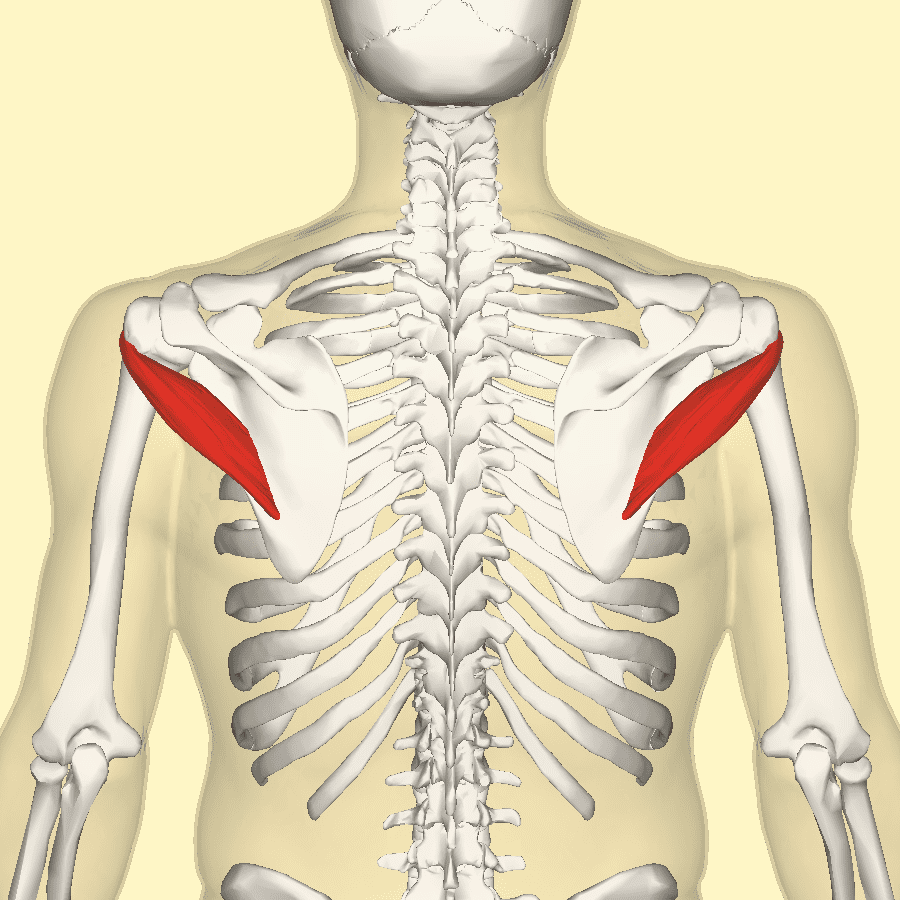Table of Contents
Introduction
The rotator cuff works together with the shoulder, providing movement and a full range of motion. The shoulders are one of the largest and most complex joints that can succumb to injuries that can make the shoulders unstable and cause unwanted pain-like symptoms to affect not only the shoulders but also the arms and the neck. These pain-like symptoms are caused by myofascial pain syndrome or trigger points. Trigger points can create small knots along the muscle fibers in any muscle group and causes referred pain to different locations in the upper body. One of the muscles that can be affected by trigger points is the teres minor muscle. Today’s article examines this muscle, how trigger points affect the teres minor muscle, and managing trigger points associated with the teres minor muscle. We refer patients to certified providers who specialize in musculoskeletal treatments to aid individuals suffering from trigger points associated with shoulder joints and the teres minor muscles. We also guide our patients by referring them to our associated medical providers based on their examination when appropriate. We ensure that education is the solution to asking our providers insightful questions. Dr. Jimenez DC observes this information as an educational service only. Disclaimer
What Is The Teres Minor Muscle?

Have you been experiencing shoulder pain? Do you feel a tingling sensation that runs down to your fingertips? What about spasms or stiffness in your shoulders? Most of these symptoms are caused by trigger points associated with shoulder pain along the teres minor muscles. The teres minor muscles are part of the muscle group that supports the rotator cuffs. These muscles include the subscapularis, teres minor, supraspinatus, and infraspinatus and together assist in stabilizing the shoulder joint and even help perform arm movement. For the teres minor, this muscle is a narrow intrinsic shoulder muscle that extends from the lateral border of the scapula (shoulder blade). The teres minor is deep to the deltoid muscle as it has functions parallel to the other rotator cuff muscles, especially the infraspinatus. Studies reveal that even though the teres minor is often overlooked in normal shoulder function. To that point, the teres minor muscle becomes a key component for maintaining shoulder function when the other rotator cuff tendons fail from pathology that affects the shoulder and the rotator cuff joint.
How Do Trigger Points Affect The Teres Minor Muscle?

When pathology begins to affect the body, it affects the shoulders and the rotator cuffs. When pain affects the rotator cuffs, trigger points can develop and cause associated pain-like symptoms along the shoulders. Shoulder pain is the third common disorder in the musculoskeletal system. When the corresponding muscles in the shoulder are affected, trigger points can mimic other conditions that make it difficult to diagnose. According to Dr. Janet G. Travell, M.D., many patients often complain more of the pain rather than the restricted motion of their shoulders. This is due to the infraspinatus muscle being affected by active trigger points, causing referred shoulder pain. To that point, infraspinatus-referred pain dominates and releases tension to the parallel muscle fibers, the teres minor. Other issues like hypertrophy can also affect the teres minor when there are rotator cuff tears. Studies reveal that when the rotator cuff suffers damage and begins to tear, it could potentially lead to teres minor hypertrophy and cause referred pain-like symptoms along the upper arm. Fortunately, there are ways to manage trigger points associated with the teres minor to alleviate the pain.
Treating Myofascial Teres Minor Pain- Video
Feeling aches and pain when you are rotating or lifting your shoulders? What about feeling pain in your upper arm? Or do you feel tenderness on your shoulders or upper arm? Many people experiencing pain along their shoulders might be due to trigger points affecting the teres minor muscle. The teres minor muscle is part of the rotator cuff and helps stabilize the shoulders to prevent instability. When factors cause dysfunction in the rotator cuff can lead to the development of trigger points associated with the teres minor muscle, causing overlapping referred pain to the shoulders. Studies reveal that individuals who overuse their shoulder muscles can make them hypersensitive to mechanical pain. To that point, this allows active trigger points to play a role in the development of shoulder pain along the teres minor muscle. The video above shows where the teres minor muscle is located and how to release the trigger points from the muscle to reduce pain in the shoulders and the upper arms while preventing disability.
Managing Trigger Points Associated With The Teres Minor Muscle

When many individuals suffer from shoulder pain associated with trigger points, they often explain and show their primary doctor where the pain is. Their doctors then examine their patients to pinpoint where the issue is before diagnosing the symptoms that are affecting them. Once the symptom is diagnosed as trigger points associated with shoulder pain, doctors would refer their patients to pain specialists like chiropractors or massage therapists to manage and reduce trigger points affecting their shoulders. Many pain specialists will use various techniques to relieve shoulder pain associated with trigger points. Studies reveal that the effects of dry needling on active trigger points in the teres muscle are effective for improving pain intensity, inter rotation range of motion, and extensibility on the shoulder. Other ways to manage trigger points associated with the teres minor muscle include:
- Reducing or avoiding excessive or repetitive load on the muscle
- Have a correct sleeping position to prevent shortening the shoulder muscles
- Applying a hot compress on the muscle to relax the stiff muscle and reduce trigger points from forming further
- Doing stretching exercises to relieve shoulder tension
Incorporating these can help restore shoulder mobility and prevent future trigger points from forming and causing shoulder pain.
Conclusion
The teres minor is part of a muscle group that supports the rotator cuffs in the shoulder. These muscles stabilize the shoulder joint and help perform arm movement. The teres minor is a narrow muscle extending the scapula’s lateral border (shoulder blade). When pathologies begin to affect the muscles in the shoulder area, it can lead to the development of trigger points along the teres minor muscle and cause referred pain along the shoulders and upper arms. To that point, many individuals will regain their range of motion in their shoulders without pain. Various treatments can help reduce the effects of referred pain along the shoulders and manage trigger point pain associated with the teres minor muscles.
References
Ceballos-Laita, Luis, et al. “Effects of Dry Needling in Teres Major Muscle in Elite Handball Athletes. A Randomised Controlled Trial.” Journal of Clinical Medicine, MDPI, 20 Sept. 2021, www.ncbi.nlm.nih.gov/pmc/articles/PMC8466529/.
Juneja, Pallavi, and John B Hubbard. “Anatomy, Shoulder and Upper Limb, Arm Teres Minor Muscle.” In: StatPearls [Internet]. Treasure Island (FL), StatPearls Publishing, 15 May 2022, www.ncbi.nlm.nih.gov/books/NBK513324/.
Ortega-Santiago, Ricardo, et al. “Pressure Pain Hypersensitivity and Referred Pain from Muscle Trigger Points in Elite Male Wheelchair Basketball Players.” Brazilian Journal of Physical Therapy, Associação Brasileira De Pesquisa e Pós-Graduação Em Fisioterapia, 2020, www.ncbi.nlm.nih.gov/pmc/articles/PMC7351965/.
Tokish, John M., et al. “Teres Minor Hypertrophy Is a Common and Negative Predictor of Outcomes after Rotator Cuff Repair.” Orthopaedic Journal of Sports Medicine, SAGE Publications, 29 July 2016, www.ncbi.nlm.nih.gov/pmc/articles/PMC4968368/.
Williams, Matthew D, et al. “Understanding the Importance of the Teres Minor for Shoulder Function: Functional Anatomy and Pathology.” The Journal of the American Academy of Orthopaedic Surgeons, U.S. National Library of Medicine, 1 Mar. 2018, pubmed.ncbi.nlm.nih.gov/29473831/.
Disclaimer
Post Disclaimer
Professional Scope of Practice *
The information herein on "The Teres Minor Muscle Affected By Trigger Points" is not intended to replace a one-on-one relationship with a qualified health care professional or licensed physician and is not medical advice. We encourage you to make healthcare decisions based on your research and partnership with a qualified healthcare professional.
Blog Information & Scope Discussions
Welcome to El Paso's Wellness blog, where Dr. Alex Jimenez, DC, FNP-C, a board-certified Family Practice Nurse Practitioner (FNP-C) and Chiropractor (DC), presents insights on how our team is dedicated to holistic healing and personalized care. Our practice aligns with evidence-based treatment protocols inspired by integrative medicine principles, similar to those found on dralexjimenez.com, focusing on restoring health naturally for patients of all ages.
Our areas of chiropractic practice include Wellness & Nutrition, Chronic Pain, Personal Injury, Auto Accident Care, Work Injuries, Back Injury, Low Back Pain, Neck Pain, Migraine Headaches, Sports Injuries, Severe Sciatica, Scoliosis, Complex Herniated Discs, Fibromyalgia, Chronic Pain, Complex Injuries, Stress Management, Functional Medicine Treatments, and in-scope care protocols.
Our information scope is limited to chiropractic, musculoskeletal, physical medicine, wellness, contributing etiological viscerosomatic disturbances within clinical presentations, associated somato-visceral reflex clinical dynamics, subluxation complexes, sensitive health issues, and functional medicine articles, topics, and discussions.
We provide and present clinical collaboration with specialists from various disciplines. Each specialist is governed by their professional scope of practice and their jurisdiction of licensure. We use functional health & wellness protocols to treat and support care for the injuries or disorders of the musculoskeletal system.
Our videos, posts, topics, subjects, and insights cover clinical matters, issues, and topics that relate to and directly or indirectly support our clinical scope of practice.*
Our office has reasonably attempted to provide supportive citations and has identified the relevant research studies or studies supporting our posts. We provide copies of supporting research studies available to regulatory boards and the public upon request.
We understand that we cover matters that require an additional explanation of how they may assist in a particular care plan or treatment protocol; therefore, to discuss the subject matter above further, please feel free to ask Dr. Alex Jimenez, DC, APRN, FNP-BC, or contact us at 915-850-0900.
We are here to help you and your family.
Blessings
Dr. Alex Jimenez DC, MSACP, APRN, FNP-BC*, CCST, IFMCP, CFMP, ATN
email: coach@elpasofunctionalmedicine.com
Licensed as a Doctor of Chiropractic (DC) in Texas & New Mexico*
Texas DC License # TX5807
New Mexico DC License # NM-DC2182
Licensed as a Registered Nurse (RN*) in Texas & Multistate
Texas RN License # 1191402
ANCC FNP-BC: Board Certified Nurse Practitioner*
Compact Status: Multi-State License: Authorized to Practice in 40 States*
Graduate with Honors: ICHS: MSN-FNP (Family Nurse Practitioner Program)
Degree Granted. Master's in Family Practice MSN Diploma (Cum Laude)
Dr. Alex Jimenez, DC, APRN, FNP-BC*, CFMP, IFMCP, ATN, CCST
My Digital Business Card


